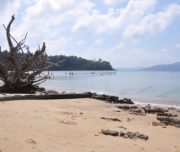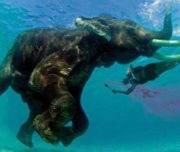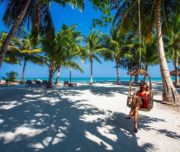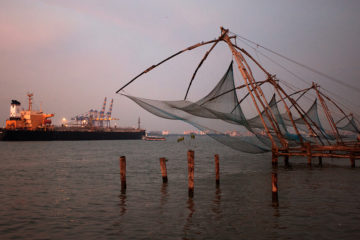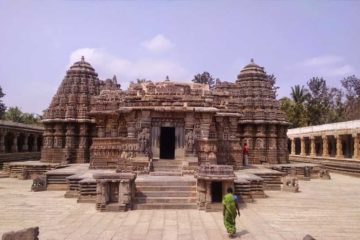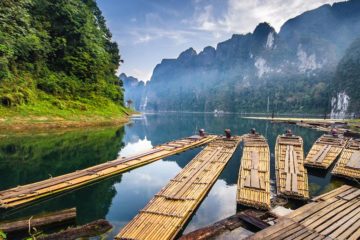The Andaman Islands are an Indian archipelago in the Bay of Bengal. These roughly 300 islands are known for their palm-lined, white-sand beaches, mangroves and tropical rainforests. Coral reefs supporting marine life such as sharks and rays make for popular diving and snorkeling sites. Indigenous Andaman Islanders inhabit the more remote islands, many of which are off limits to visitors.
| TOURS DURATION | 06 days and 05 Nights | ||||
| PlACE COVERED | Chidiya Tapur – Port Blair- North Bay- Havelock Island – Elephant Beach | ||||
| INCLUDED |
|
||||
| NOT INCLUDED |
|
Tourists get attracted with so many wonders that are here.
DAY - 01 : Arrival Port Blair Visit Chidiya Tapu
You will enjoy memorable vacation in this beautiful tropical paradise. Upon arrival at Port Blair, transfer to the hotel. Freshen up and get ready to visit Chidiya Tapu located 31 kms from Port Blair. Chidiya Tapu is magnificently covered by the green mangroves and beautiful beach, from where magnificent view of the sun-set is enjoyed viewing. In the evening visit to the historical Cellular Jail to attend the fascinating Light and sound show, which brings alive the sacrifices and struggle of the thousands of the freedom fighters of India. After Completion of tour,
back to the hotel for an overnight stay at the hotel in Port Blair.
DAY - 02 : Port Blair - North Bay - Port Blair
In morning after breakfast local sightseeing proceed for a full day Excursion to North Bay (Coral Island) to enjoy the magnificent and alluring view of the Coral Reefs and ornamental colourful fishes and other Marine Life. The glass bottom boat ride helps one to enjoy the magnificent and alluring view of the vast coral reefs and various species of marine creatures. Overnight stay will be at the hotel in Port Blair.
DAY - 03 : Port Blair - Havelock Island
Enjoy the hearty breakfast in morning at the hotel. After the breakfast visit to Havelock Island located at the distance of 57 kms by sea from Port Blair. On arrival spend overnight amidst the lush green forest and the sandy beaches staying in the comfortable beach resort. After some rest enjoy visit to the Aisa’s Best Beach “Radhanagar Beach”. Overnight stay at the hotel in Havelock.
DAY- 04 : Havelock - Elephant Beach - Havelock
After the breakfast get ready for a half day sightseeing of Elephant beach to enjoy the adventurous and thrilling water sports especially snorkelling. Snorkelling is a leisure water sports in which a person swims over the surface of the water wearing the face mask. During snorkelling you can enjoy the alluring view of the coral reefs and the rich marine life. Overnight stay at the hotel.
DAY - 05 : Havelock - Port Blair
After breakfast in morning, enjoy as you want, Its free time to go and see local places and other attractive places. Afternoon return back to Port Blair check in at hotel for an overnight stay.
DAY - 06 : Port Blair - Departure
Check out from the hotel after the breakfast in the morning and transfer to the airport to connect flight for onwards journey or way back home.
General Inclusions:-
- Transportation: Airport Transfers and Sightseeing as per the above-itinerary by AC Vehicle like Scorpio / Xylo / Ertiga / Tavera / Datsun GO or similar at Port Blair & AC Vehicle Like Sumo
- All kind of transport and luxury Taxes.
- 03 – star Accommodation in bed & breakfast basis.
- Assistance at all arrival and departure points.
- All other specified expenses and activities.
- To and fro tickets to Havelock by AC Green Ocean/ Coastal Cruise / similar (Base Category Seats)
- Entry permits/Entry tickets/Boat tickets/Ferry tickets wherever required.
- Parking Charges.
The Tour does not include:
- Cost for supplementary service, optional Tours, Up-gradation Charges, Guide,
- Additional Sightseeing entrance fees.
- Cost for Airfare, Train fare, Insurance Premiums,
- Cost for service provided on a personal request.
- Cost for personal expenses such as laundry, bottled water, soft drinks, incidentals, porter charges, tips etc.
- Activity charges, Scuba, Jet Ski, Snorkeling etc., until and unless mentioned in the inclusions.
- Cost for any other service not mentioned under the “Cost Includes” head.
- Difference in cost arising due to change in Taxes by the Government which will have to be collected directly ON ARRIVAL.
- Difference in cost arising due to extra usage of vehicle, other than scheduled & mentioned in the itinerary.
- Difference in cost arising due to mishaps, political unrest, natural calamities like – landslides, road blockage, etc. In such case extra will have to be paid on the spot by the guest directly.
- Camera Fee ( Still or Movie)
VISA INFORMATION
OVERVIEW
All foreign nationals entering India are required to possess a valid international travel document in the form of a national passport with a valid visa obtained from an Indian Mission or Post abroad.
All Individual visa seekers are requested to apply for the Indian Visa through Online application link , in order to make an application for getting the Indian visa.
The duly signed physical copy of the application form completed in all respect and submitted successfully, is to be submitted at the concerned Indian Visa Application Center (IVAC) or directly to Indian Mission/ Post, on the scheduled date of interview along with the requisite supporting documents. The instructions for filling the form and scheduling the appointment can be seen at Instructions for Online Visa Application. Important technical information for filling online Indian visa application can be referred at Technical Instructions.
The applicants are also requested to visit website of the Indian Mission concerned for detailed information about Indian visa.
ONLINE VISA APPLICATION
All Individual visa seekers are requested to apply for the Indian Visa through online application link. Or can apply by typing the URL: http://indianvisaonline.gov.in/visa/ in the address bar of web browser, in order to make an application for getting the Indian visa. In either case, no hand written application form will be accepted by any of the Indian Mission/ Post, where-ever online Visa facility has been implemented. The application form completed in all respect and submitted succesfully, is to be submitted at the concerned Indian Visa Application Center (IVAC) or directly to Indian Mission/ Post in absence of IVAC, on the scheduled date of interview along with the requisite supporting documents. The instructions for filling the form and scheduling the appointment can be refered at Instructions for Online Visa Application. Important technical information for filling online Indian visa application can be referred at Technical Instructions. If you have already applied online for Indian Visa online and want to know the status of your application,
VISA CATEGORIES
Government of India issues the following visas: Business Visa, Conference Visa, Diplomatic Visa, Employment Visa, Emergency Visa, Entry Visa, Journalist Visa, Medical Visa, Missionaries Visa, Permit to re-enter within 2 months, Research Visa, Student Visa, Tourist Visa, Transit Visa. Please follow the link for details on Visa Provision and supporting documents
VISA PROCESSING TIME
Upon receipt of the Visa Application through Indian Visa Application Center or directly, the Indian Mission/ Post requires a minimum of three working days to process the case and issue a visa depending upon the nationality and excluding special cases.
PHOTO REQUIREMENTS
Online India Visa Application allows the Applicant to upload a digital photograph of self to complete the online visa application.
Guidelines/procedure to upload a digital photograph
The digital photograph to be uploaded along with the Visa application should meet the following requirements:
Format – JPEG
Size
Minimum 10 KB
Maximum 300 KB
The height and width of the Photo must be equal.
Photo should present Full face, front view, eyes open.
Center head within frame and present full head from top of hair to bottom of chin.
Background should be plain light colored or white background.
No shadows on the face or on the background.
Without borders.
Make sure that photo presents full head from top of hair to bottom of chin. Head should measure 1 inch to 1-3/8 inches (25mm to 35mm). Make sure eye height is between 1-1/8 inches to 1-3.
FEE FOR INDIAN VISA
The visa fee depends upon the type of applied for and duration of visa. Visa fee is divided into various types depending upon the case viz; Basic fee, special fee, processing fee by out-sourcing agency. During the online registration process, at the end of the process the basic fee shall be displayed. However, this fee shall be indicative only and final fee shall be charged while submitting the application at the respective counters Fee once received are non-refundable even if the visa application is withdrawn, the visa is not granted, or if visa issued is of shorter duration of period than applied for or otherwise issued or returned at a time or on terms and conditions that may vary from those sought by the applicant. For further information on this, please check with local embassy office or Indian Visa Application center office or websites for information on applicable fee and payment methods.
VISA PROVISION
| Sl. No. | Type of Visa | Period for which granted | Entry – Single (S), Multiple (M), Double | Documents required with application | Extendable in India |
| 1 | Tourist | 180 days | M | – | No |
| 2 | Transit | 15 days | S/ Double | Return/ onward journey ticket | No |
| 3 | Business | 5 years | M | Documents to prove bonafide purpose (Company’s letter etc.) | Yes |
| 4 | Employment | 1 year/ period of contract | M | Proof of employment (appointment document), terms and conditions | Yes |
| 5 | Student | Period of course/ 5 years | M | Proof of admission in Indian Institution | Yes |
| 6 | Foreigners of Indian Origin | 5 years | M | Proof of being of Indian Origin | Yes |
INSTRUCTIONS
- Online application form:
This application form is meant for those foreigners who are applying for visa from outside India.
Each online application form is meant for one person only. Separate application has to be filed for each applicant.
Furnish information exactly in the manner asked for in the forms, especially the names, address and date of birth.
Applicants are required to verify the application details before submitting the online application. They have an option to save the online application form, in case it is not to be submitted.
Once the online application form is submitted by the applicant, then further modifications are not allowed. Hence applicants are requested to check and validate the details before submitting the online application form.
Applicants are requested to keep the Application Id (generated automatically after the submission of online form) for further communications.
- Appointment Scheduling:
Applicant can schedule the appointment as per his/ her convenience with the concerned Indian Mission.
Each applicant to schedule a separate appointment with the Indian Mission
- Process for filling up online application form:
Applicant shall access the Visa Application system online through the following link: http://indianvisaonline.gov.in/visa/.
Applicant visits the above mentioned web link and selects the Indian Mission from where he intends to apply for the Visa from the tab “Select Mission”.
Applicant fills the application on-line as per the forms standardized by the Ministry.
After filling the form and submitting it, the system shall automatically generate a Application Id. Applicants are requested to keep this Application Id for further communications with the concerned Indian Mission.
System will automatically ask the Applicant for the following confirmation: “Select ‘Yes’ if the applicant want to seek appointment and make payment online or ‘No’ if the applicant just want to print the submitted application form.”
If the applicant response is “No”, then it is requested by the applicant to take the print out of the submitted online application form and approach the concerned Indian Mission for submission of the online form along with supporting documents.
If the response from applicant is “yes” then the system automatically takes the link to perform the following:
Selection of Date and Time of appointment at the concerned Indian Mission
Calculation of Visa fee, service charge, VAT etc. as applicable according to the Visa type
E Payment using service provider’s payment system
In case the facility of Appointment Scheduling and e-Payment is not available for the concerned Indian mission, then applicant has to take the printout of the online application form and visit the concerned Indian Mission to submit the same along with supporting documents and make the payment.
Indian Culture: Traditions and Customs of India
India’s culture is among the world,s oldest; civilization in India began about 4,500 years ago. Many sources describe it as “Sa Prathama Sanskrati Vishvavara” — the first and the supreme culture in the world, according to the All World Gayatri Pariwar (AWGP) organization.
Western societies did not always see the culture of India very favorably, according to Christina De Rossi, an anthropologist at Barnet and Southgate College in London. Early anthropologists once considered culture as an evolutionary process, and ”every aspect of human development was seen as driven by evolution,” she told Live Science. “In this view, societies outside of Europe or North America, or societies that did not follow the European or Western way of life, were considered primitive and culturally inferior. Essentially this included all the colonized countries and people, such as African countries, India, and the Far East.”.
However, Indians made significant advances in architecture (Taj Mahal), mathematics (the invention of zero) and medicine (Ayurveda). Today, India is a very diverse country, with more than 1.2 billion people, according to the CIA World Factbook, making it the second most populous nation after China. Different regions have their own distinct cultures. Language, religion, food and the arts are just some of the various aspects of Indian culture. Here is a brief overview of the culture of India.
Language
India has 28 states and seven territories, according to the World Health Organization. There is no official language in India, according to a Gujarat High Court ruling in 2010. Many people living in India also write in Devanagari script. In fact, it is a misconception that the majority of people in India speak Hindi. Though many people speak Hindi in India, 59 percent of India residents speak something other than Hindi, according to The Times of India. Bengali, Telugu, Marathi, Tamil and Urdu are some other languages spoken in the country.
Religion
India is identified as the birthplace of Hinduism and Buddhism, the third and fourth largest religions. About 84 percent of the population identifies as Hindu, according to the “Handbook of Research on Development and Religion” Edited by Matthew Clarke (Edward Elgar Publishing, 2013). There are many variations of Hinduism, and four predominant sects — Shaiva, Vaishnava, Shakteya and Smarta.
About 13 percent of Indians are Muslim, making it one of the largest Islamic nations in the world. Christians and Sikhs make up a small percentage of the population, and there are even fewer Buddhists and Jains, according to the “Handbook.”
Food
When the Moghul Empire invaded during the sixteenth century, they left a significant mark on the Indian cuisine, according to Texas A&M University. Indian cuisine is also influenced by many other countries. It is known for its large assortment of dishes and its liberal use of herbs and spices. Cooking styles vary from region to region.
Wheat, Basmati rice and pulses with chana (Bengal gram) are important staples of the Indian diet. The food is rich with curries and spices, including ginger, coriander, cardamom, turmeric, dried hot peppers, and cinnamon, among others. Chutneys — thick condiments and spreads made from assorted fruits and vegetables such as tamarind and tomatoes and mint, cilantro and other herbs — are used generously in Indian cooking.
Many Hindus are vegetarians, but lamb and chicken are common in main dishes for non-vegetarians. The Guardian reports that between 20 percent and 40 percent of India’s population is vegetarian.
Much of Indian food is eaten with fingers or bread used as utensils. There is a wide array of breads served with meals, including naan, a leavened, oven-baked flatbread, and bhatoora, a fried, fluffy flatbread common in North India and eaten with chickpea curry.
Architecture and art
The most well-known example of Indian architecture is the Taj Mahal, built by Mughal emperor Shah Jahan to honor his third wife, Mumtaz Mahal. It combines elements from Islamic, Persian, Ottoman Turkish and Indian architectural styles. India also has many ancient temples.
India is well known for its film industry, which is often referred to as Bollywood. The country’s movie history began in 1896 when the Lumière brothers demonstrated the art of cinema in Mumbai, according to the Golden Globes. Today, the films are known for their elaborate singing and dancing.
Indian dance, music and theater traditions span back more than 2,000 years, according to Nilima Bhadbhade, author of “Contract Law in India” (Kluwer Law International, 2010). The major classical dance traditions — Bharata Natyam, Kathak, Odissi, Manipuri, Kuchipudi, Mohiniattam and Kathakali — draw on themes from mythology and literature and have rigid presentation rules.
Clothing
Indian clothing is closely identified with the colorful silk saris worn by many of the country’s women. The traditional clothing for men is the dhoti, an unstitched piece of cloth that is tied around the waist and legs. Men also wear a kurta, a loose shirt that is worn about knee-length. For special occasions, men wear a sherwani, which is a long coat that is buttoned up to the collar and down to the knees. The Nehru jacket is a shorter version of a sherwani.
Customs and celebrations
The country celebrates Republic Day (Jan. 26), Independence Day (Aug. 15) and Mahatma Gandhi’s Birthday (Oct. 2). Diwali is the largest and most important holiday to India, according to National Geographic. It is a five-day festival known as the festival of lights because of the lights lit during the celebration to symbolize the inner light that protects them from spiritual darkness. Holi, the festival of colors, also called the festival of love, is popular in the spring.
Weather
India is situated in Southern Asia, bordering the Arabian Sea and the Bay of Bengal, between Burma and Pakistan.
The climate in India varies from a tropical monsoon climate in the south to a temperate climate in the north. If you are thinking of Visiting Delhi (the capital of India) then best to visit it in October, November, February and March. That’s when the nights are cool and the days are filled with a little sunshine. May, June and July are very hot with temperatures over 45 degrees (113 Fahrenheit). It is a dry heat and is sometimes accompanied by dusty desert winds. Most of the rain falls between July and September but they are not the tropical rains you’ll experience in India’s coastal cities.



